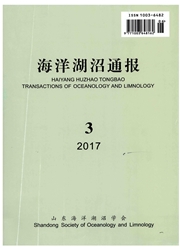

 中文摘要:
中文摘要:
于2012年6月10日浒苔爆发早期、2012年7月26日浒苔大量爆发期及2012年9月18日浒苔消退后在青岛太平湾砂质潮间带开展小型底栖动物的采样调查,讨论大型绿藻爆发对小型底栖动物群落结构及分布的影响。本研究共鉴定15个小型底栖动物类群,海洋线虫占据绝对优势(69.3%~97.9%),其次为桡足类(0.2%~18.7%)和涡虫类(0.2%~17.5%)。在浒苔爆发早期,小型底栖动物的平均丰度为(1036.5±788.6)ind.10cm^-2;在浒苔大量爆发期平均丰度为(815.3±492.3)ind.10cm^-2;在浒苔消退后平均丰度为(864.7±380.9)ind.10cm^-2。浒苔大量爆发使海洋线虫优势度增加,桡足类比例降低,对小型底栖动物群落数量及结构的影响因潮带不同而具有差异。总体而言,浒苔爆发的影响最先表现为使具有良好暴露程度的中潮带和高潮带小型底栖动物丰度降低,对低潮带小型底栖动物丰度的影响不明显。高潮带海洋线虫丰度在浒苔爆发期显著低于消退后,以深层分布为主;浒苔消退后恢复表层、次表层分布为主。表明浒苔爆发期线虫主要可通过垂直迁移迁出受胁迫的环境;浒苔消退后,通过水平和垂直迁移迅速进入恢复后的环境。与此相反,高潮带桡足类在浒苔大量爆发时显著增加,并以深层分布为主,与生存竞争压力降低和浒苔附植桡足类的补充有关。本研究结果显示小型底栖动物丰度与沉积物叶绿素浓度有着显著的正相关性,而浒苔的爆发正是造成叶绿素浓度变化的主要原因。此外,浒苔爆发还可通过影响沉积物溶解氧含量最终对小型底栖动物产生负面影响。
 英文摘要:
英文摘要:
The effect of green algal (Enteromorpha prolifera in particular) blooms on the community structure and distribution of sandy intertidal meiofauna was studied in Taiping Bay, Qingdao. A total of 15 main meiofauna groups were identified, of them nematode was the most dominant in all three studied periods (69.3%~97.9%), which was followed by copepods (0.2 %~18.7%) and turbellarians (0.2% ~17.5%). The average abundance of meiofauna was 1,036.5!788.6 ind. 10cm 2 in the early phase of bloom (June). During the massively blooming phase (July), meiofauna abundance declined approxi- mately by 20% to 815.3~492.3 ind. 10cm-2. Such abundance increased again after the regression of green algae to 864.7 + 380.9 ind. 10cm-2. The dominance of nematode increased obviously while the proportion of copepod declined during blooms. With regard to horizontal distribution of meiofauna, al- gal blooms decreased the meiofaunal abundance in the mid-tidal and high-tidal zones which usually have good exposure conditions. However, algal blooms showed mere effect on meiofauna abundance in the low-tidal zone. Compared to the phase after the regression of green algae, nematode abundance de- creased and mainly distributed in deep layers of the sediment during the massively blooming in high-tid- al zone, suggesting that nematode may escape from the stressed environment by vertically migrating in- to deeper layers and back to the recovered environment after the regression. In stark contrast, howev- er, copepod abundance increased significantly during the massively blooming in high-tidal zone, which associated with decreasing of survival competitive pressure and supplementation of phytal copepod. The results of present study revealed that meiofauna/nematode abundance significantly correlated with sedi- ment chlorophyll-a concentration. The green algal blooms were responsible for the variation of ehloro- phyll-a. In addition, the change in dissolved oxygen content was also related to the reduction of meio- fauna abundance.
 同期刊论文项目
同期刊论文项目
 同项目期刊论文
同项目期刊论文
 Environmental factors affecting nematode community structure in the Changjiang Estuary and its adjac
Environmental factors affecting nematode community structure in the Changjiang Estuary and its adjac Gilvimarinus chinensis gen. nov., sp nov., an agar-digesting marine bacterium within the class Gamma
Gilvimarinus chinensis gen. nov., sp nov., an agar-digesting marine bacterium within the class Gamma Flaviflexus huanghaiensis gen. nov., sp. nov., a novel actinobacterium of the family Actinomycetacea
Flaviflexus huanghaiensis gen. nov., sp. nov., a novel actinobacterium of the family Actinomycetacea Enoplus taipingensis, a new species of marine nematode from the rocky intertidal seaweeds in the Tai
Enoplus taipingensis, a new species of marine nematode from the rocky intertidal seaweeds in the Tai An evaluation on combination effects of phenolic endocrine disruptors by estrogen receptor binding a
An evaluation on combination effects of phenolic endocrine disruptors by estrogen receptor binding a 期刊信息
期刊信息
